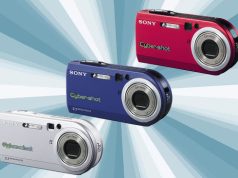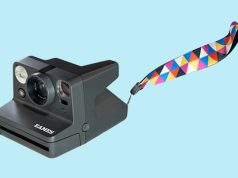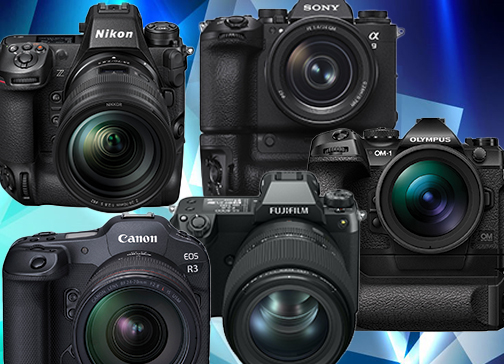
“Real pros no longer shoot with DSLRs—they’re all into mirrorless!” That unvarnished view, recently expressed by the head techie at a major camera company, is a little over the top. However, it points to the culmination of a trend that began in 2007 when Sony released the first professional, full-frame mirrorless camera—the α7. There are a few “real pros” who still rely on their beloved DSLRs, and you can still purchase a new high-end pro-level DSLR. Among them are the Nikon D6 ($6,499.95) and Canon EOS-ID X Mark III ($6,449). Nonetheless, professional mirrorless cameras are now the overwhelming choice of working pros and increasing numbers of serious enthusiasts.
These professional mirrorless cameras are favored by tech-savvy pros because they provide continuous autofocus (AF) during the actual exposure. This is crucial in capturing crisp, full-res high-speed bursts as well as seamless video in 4K to 8K. Eliminating the mirror box also enables mirrorless cameras to be smaller and lighter. Additionally, their shorter lens-to-sensor distance allows optical designers to create smaller, lighter, higher-performance lenses. This also permits users to mount a huge variety of existing lenses via simple adapters.
Another huge factor: with the ascendence and near-total dominance of mirrorless cameras, manufacturers have put all their best and latest technology into their high-end mirrorless models. This includes state-of-the art BSI (backside-illuminated) CMOS sensors; ultrafast image processors; AF systems based on artificial intelligence (AI); advanced image stabilization (IS) systems; as well as superspeed shutters with high-speed sync. Let’s not forget ultrahigh-resolution, high-magnification electronic viewfinders (EVF) with blistering refresh rates; high-res, articulated touchscreens; as well as a host of special features unique to each brand. The sheer technical audacity of these cameras is evident when you peruse the specs and performance parameters of our picks for 2024.
Formidable Professional Mirrorless Cameras
Even if you limit your focus to top-tier professional mirrorless cameras, today’s models are an extensive, immensely varied, endlessly fascinating and eminently marketable category. Consequently, we couldn’t possibly cover all of them here. Other worthy contenders that come to mind include the Sony α 7R V, Olympus OM-D E-M1X, Leica SL 2, Nikon Z 7II, Fujifilm X-H2S and Canon EOS R6 Mark II. We hope that our write-ups inspire you to check them out. You’ll all be glad you did. Herewith is our abbreviated selection of professional mirrorless cameras.
Sony Alpha 9 III
Recently released, the Sony Alpha 9 III full-frame mirrorless camera is a technological tour de force with a host of advanced features and unique capabilities. Moreover, it’s the first and only full-frame mirrorless camera to incorporate a global shutter, which far surpasses the rolling shutter used for decades. As a result, it eliminates rolling shutter effects as well as banding, which often show up in mixed lighting and when shooting video. Thus, Sony extended the camera’s capabilities in sports and wildlife photography, photojournalism and more. This revolutionary sensor technology allows shooting RAW full-res images at up to 4K 120 frames per sec (fps) with no blackout. In addition, it achieves full flash sync up to the camera’s top shutter speed of an incredible 1/80,000 sec without HSS.
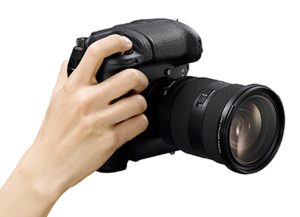
Sony mated its 24.6-megapixel CMOS sensor with a powerful Bionz XR image processor and an AI processing unit. Delivering precise, ultrafast AF, this integrated system provides a wide range of enhanced performance parameters. Among them are sensitivity settings from ISO 250 to ISO 25,600 in manual mode and extendable to ISO 125–51,200. The camera is also capable of 4K video capture at 60 fps with 6K oversampling; 120-fps high-frame-rate recording; internal 10-bit 4:2:2 recording; and 16-bit RAW output via the full-size HDMI port. In addition, it offers S-Log 3, S-Cinetone and other picture profiles for image optimization in postproduction. And you can set a pre-capture function for stills to begin recording images to the buffer anywhere from 0.05 sec to 1.0 sec before the shutter button is fully depressed.
Other Notables
The ILC’s AI-based manual and autofocus system uses 759 phase-detection points for stills and 627 phase-detection points for video. It can also focus in light levels as low as -5 EV. Other key features comprise built-in sensor-shift 5-axis image stabilization with 8 stops of compensation; a 9.44M-dot, 0.9x magnification OLED EVF; a unique 4-axis, 3.2-inch, 2.1M-dot tilt/swivel touchscreen monitor; built-in 5GHz Wi-Fi; Bluetooth 5.0; as well as GPS via a connected smartphone. In addition, it has a dedicated TTL flash via shoe mount or PC terminal and dual CFexpress Type A card slots to provide maximum versatility and speed. All this is built into the Alpha 9 III’s robust, ergonomic magnesium alloy body, which has an improved grip, a more comfortably positioned shutter release and two customizable thumb dials. $5,999.99.*
Nikon Z 9
The heart of Nikon’s rugged top-of-the-line mirrorless crossover is an FX-format (full-frame), 45.7MP BSI stacked CMOS sensor. Furthermore, it works with Nikon’s latest, most advanced Expeed 7 image processor. This state-of-the-art combo is claimed to reduce rolling shutter effects as well as deliver AF speeds 10x faster. The ILC also achieves sensitivity settings from ISO 64 to 25,600, which are expandable from ISO 32 to ISO 102,400.
The Nikon Z 9 notably provides continuous shooting speeds of 20 fps (RAW), 30 fps (JPEG) and up to 120 fps (!) when recording 11MP stills from video. What’s more, it does all that while supporting full AF and AE. Furthermore, the camera can buffer more than 1,000 RAW images in a single burst (equal to 50 seconds of continuous recording). Plus, it has a nearly silent electronic shutter with a top speed of 1/32,000 for working in bright light. No mechanical shutter is required! Furthermore, in-body vibration reduction (VR) with synchro VR (with select lenses) provides up to 6 stops of compensation to minimize the effects of camera shake.
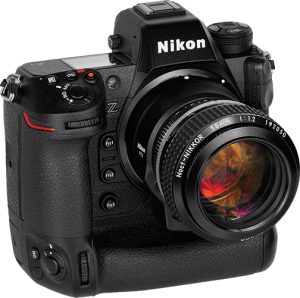
Video Features+
Its video prowess includes 8K video at 30 fps, 4K video at up to 120 fps and oversampled 4K video at 30 fps for increased sharpness and detail. Moreover, the Z 9 is capable of internal recording with 10-bit color and 4:2:2 sampling in a variety of codecs. Plus, it offers a 10-bit N-Log setting as well as HLG (Hybrid Log Gamma) for creating in-camera HDR content. Additionally, its high-speed, 493-point, phase-detection AF system enables autofocus at 120 fps and provides starlight mode for focusing down to -8.5 EV(!). It also provides subject detection with Deep Learning technology, auto-area AF, eye-detection AF, dynamic-area AF and 3D tracking.
What’s more, this mirrorless marvel incorporates a real-live 3.7M-dot OLED EVF with adjustable luminance; a 4-axis, 3.2-inch, 2.1M-dot tilting touchscreen LCD monitor; dual CFexpress Type B memory card slots that are compatible with XQD cards; as well as built-in Bluetooth and Wi-Fi connectivity (2.4 and 5GHz). It’s all built into a rugged, weather-resistant body with a magnesium alloy chassis that’s 20% smaller than Nikon’s former flagship, the Nikon D6 DSLR. $5,499.95.
Fujifilm GFX100S
The GFX100S is Fujifilm’s popular pro-caliber medium-format mirrorless camera. It scores on its ultrahigh-res 102MP, 43.8×32.9mm BSI CMOS sensor. Moreover, it features an impressively compact, ergonomic form factor. Notably, its flexibility shines in capturing still and video imagery. Plus, a comprehensive, cutting-edge feature set includes in-body sensor-shift image stabilization with up to 6 stops of compensation when using OIS-enabled lenses, as well as high-performance AF.

The camera’s high-spec sensor is integrated with an advanced X-Processor 4 image processor. The combo enables 16-bit RAW capture with a broad dynamic range. It also achieves commendably low noise as well as excellent clarity and color accuracy. What’s more, sensitivities ranging from ISO 100 to 12,800 are extendable from ISO 50 to 102,400. The G-mount camera also provides a maximum full-res burst rate of up to 5 fps.
In addition, the medium-format model records internal 4K UHD and DCI 4K 30p video at up to 4:2:0 10-bit as well as 4K 30p 10-bit via HDMI output, both at up to 400Mb/s. Plus, it simultaneously records external and internal video. Further, in the Apple ProRes RAW format, 4K UHD 30p RAW 12-bit output is also possible. The camera also uses F-Log Gamma for advanced color grading and supports HLG recording and film simulations. They are all usable simultaneously with raw external output.
And More …
Add to that a hybrid AF system with 425 selectable points covering nearly the entire sensor area. The system is also sensitive down to -5.5 EV and offers both face and eye detection. In addition, a fixed 3.7M-dot, 0.77x EVF is complemented with a 3.2-inch, 2.5M-dot, 3-way tilting touchscreen LCD. Other features include integrated Bluetooth LE and Wi-Fi connectivity; remote control capability; dual UHS-II SD memory card slots; a top-mounted, 1.8-inch sub-LCD monitor that displays settings and exposure data; and an exposure mode dial with six customizable settings. Fujifilm houses all this in a tough, lightweight, magnesium alloy body with comprehensive sealing that renders it moisture and dust resistant as well as freezeproof down to 14°F. $5,999.95.
Panasonic Lumix S5 IIX
Panasonic optimized this ILC for content creators requiring robust capabilities for stills, video and livestreaming. The second-generation, full-fame, L-mount mirrorless camera employs a 24.2MP CMOS sensor. It’s married to an image processor upgraded with L2 technology to provide higher resolution and more natural description. It also achieves 2x speedier signal procession for high bit-rate video recording. Complementing this tech is a newly developed hybrid phase-detection AF system with 779 phase-detection points that delivers improved subject tracking.
Also featured are sensitivity settings from ISO 100 to 51,200, extendable from ISO 50 to 204,800. Plus, dual native ISO optimizes the balance between noise and sensitivity, using two dedicated circuits for each pixel. What’s more, the ILC has a full-res burst rate of 9 fps with the mechanical shutter and 30 fps with its electronic shutter.
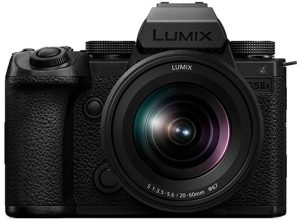
The L-mount camera also achieves full-frame 6K 30p recording with 4:2:0 10-bit color for up to 10 minutes; 4K DCI/UHD 60p video in 4:2:2 10-bit mode plus 120-fps slow motion video. And it offers RAW HDMI via an optional license upgrade. Moreover, it features real-time LUT and preinstalled V-Log and V-Gamut to capture a neutral gamma curve with a 14+ stop dynamic range for color control in postproduction. Additionally, you can shoot in 5.9K 12-bit in Apple ProRes RAW or BRAW (Blackmagic RAW) when using an Atomos or Blackmagic external recorder. Wireless/wired IP streaming is also possible.
Other Niceties
Also key is a built-in sensor-shift, 5-axis IS system that compensates for 6.5 stops of camera shake. And high-resolution mode for static subjects combines eight exposures into a single 96MB file. The Lumix S5 IIX has a 3.7M-dot OLED EVF with 0.78x magnification and a smooth refresh rate of 60 fps or 120 fps. There is also a 3-inch, 1.8M-dot, free-angle touchscreen LCD for intuitive shooting, playback and menu navigation. Other features include 2.4/5GHz Wi-Fi and Bluetooth 5.0; as well dual SD UHS-II memory card slots. Everything is ensconced in a robust, lightweight, weather-sealed magnesium alloy body. $2,199.99.
OM System Olympus OM-1
Named in commemoration of the iconic Olympus OM-1 35mm SLR of 1972, this is an assertively styled, flagship Micro Four Thirds ILC from OM Digital Solutions. While it has some visual elements linking it with the past, it offers a completely up-to-date feature set. Moreover, it delivers impressive performance in an elegant, compact, ergonomic form factor.
Its 20MP, stacked BSI Live MOS MFT sensor is combined with the latest TruePic X processor that’s three times faster than the previous engine. This combo enables the OM-1 to achieve full-res framing rates up to 10 fps and up to 120 fps without AF and AE using its electronic shutter. The ILC can also record 4K DCI/UHD 60p 10-bit video with 4:2:0 sampling and capture Full HD video at up to 240 fps. Additional video functions include 12-bit raw output via a Micro HDMI port; HLG picture mode for in-camera HDR and OM-Log Gamma for postproduction color grading.
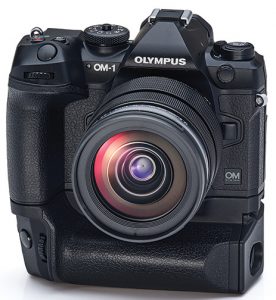
Furthermore, the camera provides ISO settings of 200–25,600 and 80–102,400 in extended mode. Its advanced autofocus system employs cross quad-pixel phase-detection AF that spits each pixel into four sub-pixels for improved performance in tricky light. Plus, its 1,053 points cover the sensor and perform at 120 fps. Complementing the AF system is 5-axis in-body IS that achieves a 7-stop advantage in minimizing the effects of camera shake. This increases to 8 stops with select IS-enabled lenses.
More Benefits
What’s more, high-res shot mode combines 12 frames into one 50MP image. This is augmented by handheld high-res mode and high-res tripod mode that raises the resolution to 80MP. Also featured is live ND that simulates a 6-stop ND 64 filter; a live composite function for long exposures; nighttime shooting and light painting; and focus stacking that records 15 sequential frames at varying distances and combines them into a single image with extended depth of field.
The OM-1 also incorporates a 5.8M-dot, 0.83x magnification OLED EVF and a vari-angle, 3-inch, 1.6M-dot touchscreen monitor. Wrapped around all this is a weather-, freeze- and splash-resistant magnesium alloy body with an IP5 rating. $2,199.99.
Note: At press time, we heard rumors of a new flagship release. The OM-1 Mark II. Stay tuned!
Canon EOS R3
The Canon R3 features a 24.1MP, full-frame, stacked BSI CMOS sensor and the company’s state-of-the-art Digic X processor. The ILC is engineered to deliver the full complement of technology from the mirrorless EOS R system along with pro performance parameters. Moreover, the stacked sensor provides ultrafast readout speeds to minimize the effects of rolling shutter distortion. Thus, it benefits video recording and high-speed burst shooting.
The advanced sensor/processor pairing also enables such impressive specs as sensitivity settings from ISO 100 to 102,400, which can expand from ISO 50 up to ISO 204,800. Along with that, the ILC achieves continuous burst rates of 30 fps at 24.1MP for 150 frames (RAW)/540 frames (JPEG) with the electronic shutter and up to 12 fps at 24.1MP for up to 1,000 frames (RAW)/100 frames (JPEG) with the mechanical shutter.
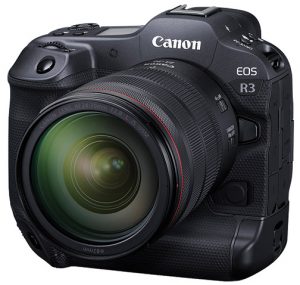
In addition, video recording specs are equally outstanding. The camera captures H.265/MP4 4:2:2 10-bit internal video in DCI 4K at 23.98, 24, 29.97, 50, 59.94 and 100 fps. Further, it records Full HD video at 23.98, 25, 29.97, 59.94 and 100 fps. It also provides external 4:2:2 10-bit video recording via HDMI in 4K DCI at 23.98, 24, 25, 29.97, 50 and 59.94 fps as well as 4K UHD at 23.98, 25, 29.97, 50 and 59.94 fps. Additionally, 6K raw video with Dual Pixel AF II tech and HDR-PQ recording are possible.
Additional Features
Other features include Dual Pixel CMOS AF II with 1,053 points covering the entire sensor area. The AF system also boasts autofocus down to -7 EV and eye control AF with focus tracking. Moreover, it provides subject detection for people, animals and vehicles. Plus, a 5-axis sensor shift in-body image stabilization (IBIS) system achieves an impressive 8-stop anti-shake-effect advantage.
Additional features include a 5.7M-dot OLED EVF with 0.76x magnification and a 120-fps refresh rate; a 3.2-inch, vari-angle, 4.3M-dot touchscreen LCD monitor; and an electronic shutter with speeds to 1/64,000 sec and flash sync up to 1/180 sec. The EOS R3 also offers 5GHz Wi-Fi and Bluetooth plus a built-in GPS module and dual card slots for CFexpress Type B and SD/SDHC/SDXC (UHS-II) cards. Moreover, its ergonomic, magnesium alloy body has an integrated vertical grip and is built to the same weather-sealed standards as Canon’s late, great flagship SLR, the EOS-1D X Mark III. $4,999.
Hasselblad X2D 100C
Offering unsurpassed performance in a timeless form factor, this modular medium-format classic uses a newly developed 100MP 43.8×32.9mm BSI CMOS sensor. It also has an all-new, in-body 5-axis, 7-stop IS system and an upgraded 294-zone phase-plus-contrast-detection AF system to achieve world-class performance.
Hasselblad’s workhorse provides sensitivity settings from ISO 64 to ISO 25,600 as well as a full-resolution burst rate of 3.3 fps. Moreover, it has an extremely wide dynamic range of up to 15 stops with 16-bit color depth—up to 281 trillion colors or 64 times higher than 14-bit! Additionally, it integrates a 1TB SSD with a 2,379MB/s write speed that stores about 4,600 RAW images or 13,800 jpegs. This, and the additional storage via the camera’s CFexpress Type B card slot, lets you shoot 16-bit RAW images in continuous drive mode.

The Hasselblad X2D 100C also incorporates an upgraded 3.6-inch, 2.4M-dot touch-and-tilt display that can be set at convenient 40° and 70° viewing angles; a full color top display screen that shows shutter speed, aperture and ISO; as well as an enhanced 5.8M-dot EVF that provides a large life-size (1.0x) view and has an electronic diopter adjustment.
Other key features comprise an electronic shutter with speeds of 1/6,000 and an in-lens mechanical leaf shutter with speeds of 1/4,000 to 4,080 sec. It also has built-in Wi-Fi and a USB 3.1 Gen 2 Type-C connection for file transfer, tethered shooting or charging via a computer or power pack. Further, it offers TTL support for a variety of Nikon flashes. Machined from individual blocks of aluminum alloy, the upper and lower shells if the X2D 100C are exquisitely crafted in the time-honored Hasselblad tradition. $8,199.
Sigma fp L
This remarkable enhancement of the innovative Sigma fp mirrorless ILC boasts an array of advanced features. The diminutive, modular, full-frame camera retains its predecessor’s L mount along with its discreet form factor. Moreover, the mirrorless masterpiece employs an ultrahigh-res 61MP full-frame BSI Bayer CMOS sensor (up from 24.6MP) with a low-pass filter. What’s more, a high-sensitivity (down to -5 EV), hybrid phase- and contrast-detection autofocus system uses 49 contrast-detection and 42 selectable points.
In addition, the diminutive fp L pairs with Sigma’s optional EVF-11 electronic viewfinder. The EVF-11 has a 0.5-inch, 3.7M-dot OLED panel for eye-level viewing and 0.83x magnification. The viewfinder also handily tilts upward 90° for low-angle shooting. Plus, the EVF has a built-in a USB-C port and a 3.5mm headphone port of its own for audio monitoring.
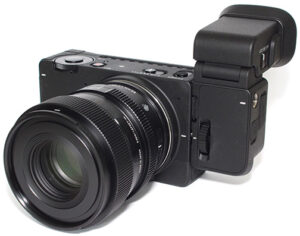
Furthermore, Sigma flagship’s upgraded sensor captures 14-bit DNG/RAW and JPEG stills. Additionally, it’s capable of recording 4K UHD video at 30p and 4K DCI 24p output if recording externally. It also records 8-bit CinemaDNG files to an SD card. Notably, it also outputs 12-bit CinemaDNG over USB C or 12-bit RAW over HDMI.
Other pro-caliber features are a 3.1-inch, 2.1M-dot LCD monitor; a crop zoom function for a 5x crop; a full-res, 10-fps burst rate; and a card slot that accepts SD/SDHC/SDXC (UHS II) cards. The Sigma fp L features a diecast, weather-resistant body. It measures just 4.4×2.8×1.8 inches and weighs a mere 15.1 ounces. $2,499 body; $2,999 with EVF-11.
Nikon Z 8
This ingenious Nikon mirrorless ILC is basically a downsized “baby Z 9” that delivers, with a few exceptions, most of the features and performance of the flagship ILC in a 30% smaller, substantially lighter package. Specifically, the Z 8 measures 5.7×4.7×3.3 inches and weighs 32 ounces, while the Z 9 measures 5.9×5.9×3.6 inches and weighs in at 47.3 ounces (both with media).
Moreover, features common to both include a 45.7MP, full-frame (FX-format) BSI stacked CMOS sensor and sensitivity settings from ISO 64 to 25,600 (32 to 102,400 extended). The two cameras also share Nikon’s top Expeed 7 image processor as well as a virtually silent 1/32,000-sec electronic shutter with full 1/200-sec flash sync and blackout-free live view (no mechanical shutter). Complementing this is a fast hybrid AF system with 493 points, 120 AF calculations per second, 3D tracking and advanced subject detection that includes aircrafts and vehicles. The Z 8 also has an impressive -9 EV AF sensitivity in low light (at f/1.2 in starlight view mode).
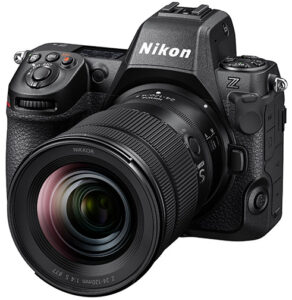
The Z 8 achieves bursts of 20 fps in RAW, 30 fps in JPEG with unlimited frames and 120 fps with JPEG (11MP). Video capture options include 8K 60p (N-RAW) and 8K 30p. Additionally, it records 125 minutes in 4K UHD 60p and 90 minutes in 8K UHD 30p. Videographers can also capture internal 12-bit RAW footage as ProRes RAW 4K 60p or 10-bit ProRes 4:2:2 HQ. Other options are N-Log and HLG (HDR). Nikon’s RAW video format, N-RAW generates a 50% smaller file size and creates a 1080p proxy file for editing. Other features include a 5-axis IS (6 stops with synchro VR and compatible lenses); a 0.5-inch EVF with 3.7M-dot resolution, a 120-fps refresh rate and 0.8x magnification; and a 3.2-inch, 2.1M-dot, 4-axis tilting touchscreen LCD.
Downsides?
The Z 8’s smaller battery delivers about 340 frames per charge when using the EVF and 370 frames when using the LCD monitor. The much bigger EN-EL18d battery in the Z 9 allows 740 and 770 shots, respectively. The Z 8 can record 4K 60p video without interruption for 125 minutes and 8K 30p for 90 minutes, whereas the Z 9 has no limits in 4K and can do two hours in 8K. Other key Z 8 features are eye-detection and wide-area AF; CFexpress and UHS-II SD slots; Bluetooth and 2.4/5GHz Wi-Fi; and an eco-friendly Seerebo carbon fiber and magnesium alloy body with comprehensive weather sealing. $3,799.95.
Sony Alpha 1
Sony’s Alpha 1 is not only the flagship of the Alpha full-frame mirrorless cameras, it’s also the most technologically advanced Sony camera ever. It employs Sony’s latest high efficiency stacked 50.1MP Exmor RS BSI CMOS sensor coupled to its most advanced state-of-the-art Bionz XR processor. This combo delivers such impressive performance parameters as a continuous full-res framing rate of 30 fps with full AF and AE. They also enable the ILC to record 8K 30p and 4K 120p 10-bit video with internal 4:2:2 10-bit sampling. Additionally, the camera outputs 16-bit raw content via the full-size HDMI port.
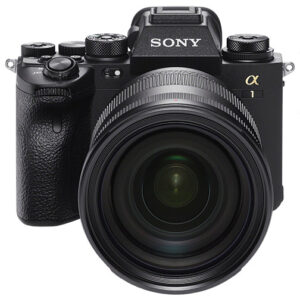
The mirrorless ILC also offers an extended sensitivity range of ISO 50-102,400 with a 15-stop dynamic range. Moreover, its sensor integrates a 759-point Fast Hybrid AF tech system with 425 contrast-detect points. Consequently, the camera achieves noticeably upgraded focus tracking. Plus, it provides real-time eye AF on people and animals and has a dedicated bird mode.
Further, Sony’s 5.5-stop, 5-axis SteadyShot InSide image stabilization corrects for pitch and yaw. The camera also boasts a 9.4M-dot OLED EVF with a 240-fps refresh rate, along with a 3-inch, 1.4M-dot, tilting touchscreen monitor. And an upgraded electronic shutter provides flash sync at up to 1/200 sec and up to 1/400 sec when used with the upgraded mechanical shutter. As you’d expect, the Alpha 1 offers an extensive range of customizable color and gamma controls, including S-Log2 and S-Log3 Gamma, and it provides XAVC and XAVC S-1 codecs for different workflows.
Additional features include Wi-Fi, Bluetooth as well as NFC connectivity; USB 3.2 Gen 1, micro-USB and Ethernet ports; plus dual memory card slots that both accept CFexpress or SD UHS-II cards. Sony housed all this and more into a tough, fully weather-sealed body built on a hardy magnesium alloy chassis. $6,499.99.
Canon EOS R5
The defining feature that sets the Canon EOS R5 apart is its newly developed 45-megapixel, full-frame CMOS sensor. The company mated the sensor with Canon’s top-end Digic X image processor. Moreover, with the flick of a switch, the R5 converts from a pro-level still camera to a full-frame 8K 60p Cinema EOS camera. It delivers impressive 8K 30p RAW video capture and 4K 120p 10-bit internal video. Other video niceties include HDMI RAW output; Canon Log 3/HLG/PQ; unlimited recording; as well as a timecode port.
For stills, the camera achieves 12-fps continuous shooting with its mechanical shutter and 20-fps bursts with the electronic shutter. Further, both shutters provide speeds up to 1/8,000 sec and top flash sync speeds of 1/250 sec. In addition, the ILC can capture 400MP image files of stationary subjects in-camera in IBIS high-resolution shot mode without extra software.
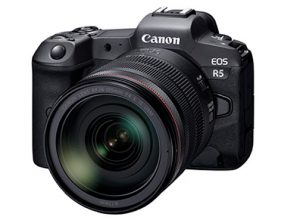
The R5’s pro-oriented feature set also includes 5-axis sensor-shift IS. Further, it integrates with the optical image stabilizer in IS-outfitted RF lenses to provide 8 stops of anti-shake compensation. Also featured is advanced Dual Pixel CMOS AF II technology that uses deep learning and 1,053 phase-detection points that cover the entire field of view for quick, decisive AF and focus tracking. And touch AF lets you choose the focus point by touching the R5’s touchscreen. What’s more, the camera’s sensitivity range of ISO 100 to 51,200 extends to ISO 102,400.
More Details
Other key features include a 0.5-inch, 5.8M-dot EVF with a quick 120-fps refresh rate for a more realistic viewfinder experience; a rear, vari-angle, 3.2-inch, 2.1M-dot LCD touchscreen monitor with a front-facing position to facilitate vlogging; and a top-mounted status LCD to review camera settings. For storage and transfer, there are CFexpress and UHS-II memory slots as well as Bluetooth and Wi-Fi 2.4/5GHz connectivity. Canon made the EOS R5’s weather-sealed body from tough polycarbonate resin on a magnesium alloy chassis. Additionally, it incorporates four distinctive control dials for intuitive tactile control and has a back joystick for easy focus point selection and menu navigation. $3,399.
*All manufacturer suggested retail prices are body only, unless otherwise noted.


